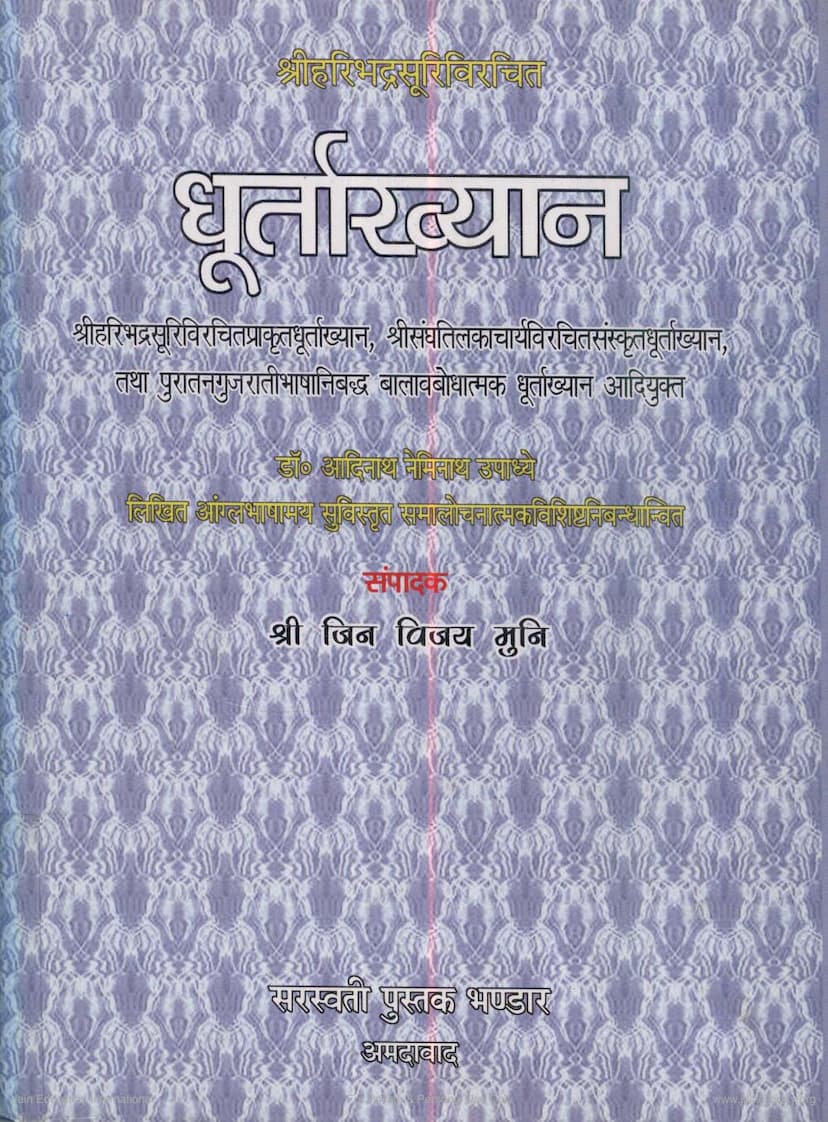Dhurtakhyan
Added to library: September 1, 2025

Summary
The provided text contains the title page, preface, table of contents, and critical study of the Jain text "Dhūrtākhyāna" (धूर्ताख्यान) by Haribhadrasuri. Here's a comprehensive summary in English:
Book Title: Dhūrtākhyāna (धूर्ताख्यान) Author(s): Haribhadrasuri (primarily), with versions by Sanghatilaka and an Old-Gujarati author. Publisher: Saraswati Pustak Bhandar, Ahmedabad. Series: Singhi Jain Series, No. 19. First Published: 1944 Reprint: 2002
Overall Summary:
The "Dhūrtākhyāna" is a significant Jain text authored by the renowned scholar Haribhadrasuri, believed to have flourished in the 8th century AD. This work is a unique satire that critically examines and ridicules the fantastical and often irrational legends found in Hindu epics like the Mahabharata and Ramayana, and the Puranas. Haribhadrasuri's primary aim was to expose the absurdity of these popular scriptures and the credulity of the masses who blindly believed in them, advocating instead for a rational, logical, and pure faith following the path of the omniscient (Sarvajña).
The text presents a frame story involving five "dhurtas" (rogues or tricksters) who, during a rainy season, are gathered and hungry. To entertain themselves and potentially win a feast, they each narrate an incredibly outlandish personal experience. To validate their tales, they then cite parallel legends from the Puranas, Mahabharata, and Ramayana. The satire is effectively delivered through the juxtaposition of these absurd personal experiences with equally, if not more, absurd Puranic narratives.
The edition under review is a critical one, edited by Acharya Jina Vijaya Muni, and includes:
- The Original Prakrit Text: Critically edited based on manuscripts, this is the core of Haribhadrasuri's work.
- Sanskrit Version: A metrical Sanskrit rendering by Sanghatilaka, a 15th-century scholar.
- Old-Gujarati Prose Rendering: An anonymous translation intended for a lay audience (Balavabodha).
- A Critical Study: An extensive and scholarly essay by Dr. A. N. Upadhye, which forms a significant part of the volume. This study delves into various aspects of the "Dhūrtākhyāna," including its purpose, technique, form, the sources of the Puranic legends cited, the Sanskrit and Gujarati versions, its comparison with "Dharma-pariksha," the Prakrit dialect and style, and the characters.
Key Aspects and Findings from the Critical Study (Dr. A. N. Upadhye):
- Purpose and Technique: The "Dhūrtākhyāna" is primarily a satire, employing witty criticism, irony, sarcasm, and humor. It uses the literary device of rogues narrating fantastical tales and confirming them with Puranic parallels, thereby ridiculing the latter. The author uses a technique similar to reductio ad absurdum to expose the weaknesses of the Puranic narratives.
- Haribhadrasuri's Genius: Haribhadrasuri is portrayed as a genius, a master storyteller, and a skilled logician, but in this work, he acts more as a witty critic. His approach is rational and intellectual, aiming to cure the masses' blind faith and superstition with reason. He demonstrates remarkable intellectual honesty by not distorting the Puranic legends but presenting them as they were and then comparing them with the rogues' equally absurd tales.
- Critique of Puranic Legends: The text directly attacks the irrational, exaggerated, and often inconsistent details found in Hindu scriptures. Haribhadrasuri concludes that these popular scriptures contain worthless material that only appears attractive from the outside, and that pious individuals should abandon them in favor of the path preached by the omniscient.
- Characters: The characters, like Muladeva, Kandarika, Elashadha, Sasa, and Khandapana, are typical rogues known in Indian picaresque literature. Khandapana, in particular, is well-individualized as a sharp-witted, cunning, and hypocritical woman rogue.
- Sources of Legends: Dr. Upadhye meticulously traces the sources of the Puranic legends cited by Haribhadrasuri, noting that while Haribhadrasuri generally refers to them generically (like Purana, Bharata), many can be identified in the Puranas and epics available today. He acknowledges the potential for variations due to oral transmission and manuscript corruptions.
- Comparison with Dharma-pariksha: The "Dhūrtākhyāna" shares a fundamental similarity in purpose with works like Amitagati's "Dharma-pariksha," both aiming to scrutinize other religions' myths and deities, often to promote Jainism. However, the "Dhūrtākhyāna" is presented as a pure satire with an artistic structure, while "Dharma-pariksha" is more overtly didactic and propagandistic.
- Prakrit Dialect and Style: The Prakrit used is analyzed as a form of Jaina Maharashtri, showing characteristics of both earlier Prakrit and later Apabhramsa stages, with a simple and fluent conversational tone suitable for the subject matter.
- Modernity of Thought: The study highlights the remarkable modernity of the "Dhūrtākhyāna" in both thought and spirit, and its masterful construction, setting it apart from many medieval Indian literary works.
Singhi Jain Series:
The preface provides a history of the Singhi Jain Series, established by Babu Bahadur Singhji Singhi in memory of his father, Babu Dalchandji Singhi. The series aims to publish scientifically and critically prepared editions of important Jain works by eminent scholars, contributing to Indological studies. The publication of the "Dhūrtākhyāna" is presented as a significant volume within this series, made possible by the patronage of Babu Bahadur Singhji Singhi and the editorial efforts of Acharya Jina Vijaya Muni.
In essence, the "Dhūrtākhyāna" is a literary gem that uses humor and sharp satire to champion reason and critical thinking against blind faith, particularly targeting the fantastical elements within widely revered Hindu scriptures. The edition is a valuable scholarly contribution to understanding this unique work and its historical context.